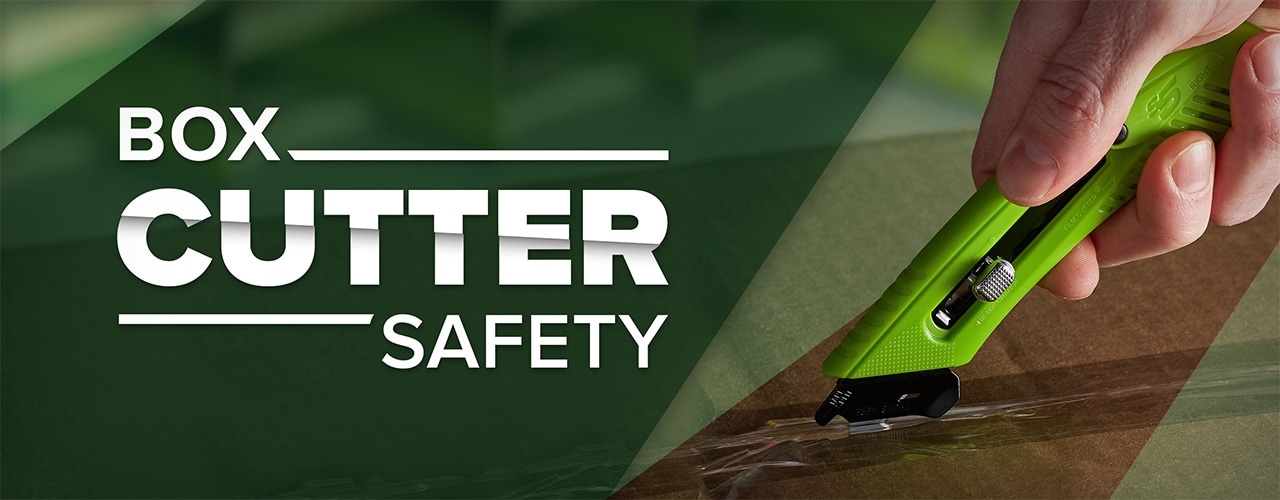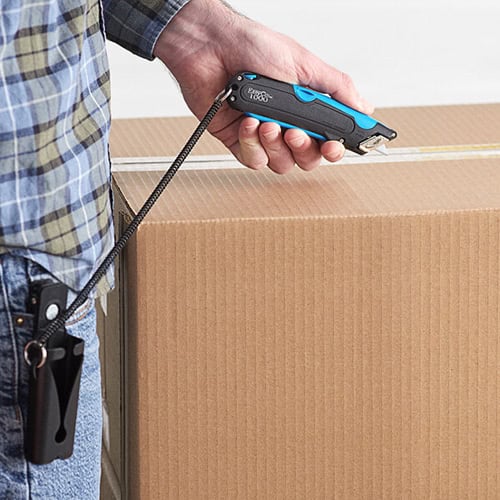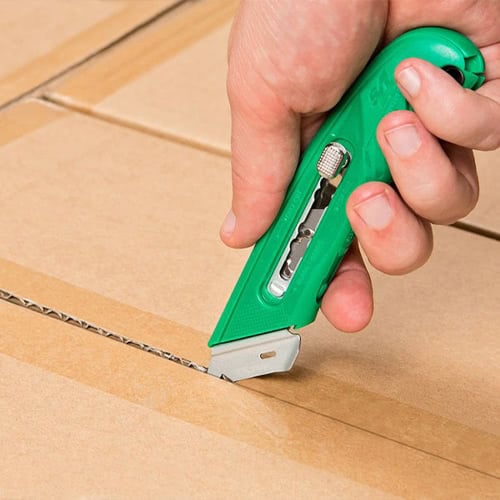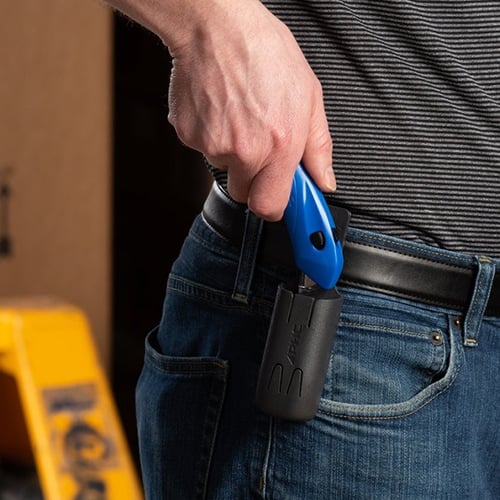
When considering warehouse safety, box cutter hazards are definitely towards the top of the list of concerns. According to OSHA, lacerations are the cause of about 30% of workplace injuries in industrial settings and can lead to around $40,000 in direct and indirect costs for a single injury. Hand injuries are the second most common injury to occur in a workplace, ranging from small nicks to deep cuts requiring medical attention. With the number of boxes that need to be broken down in warehouses, foodservice, and retail settings, it is essential that your employees know how to safely handle box cutters and industrial knives, and that they are aware of how to respond should an injury occur.
Shop all Box and Bag CuttersHow to Use a Box Cutter
Watch our video to learn the safest way to use a box cutter:
Box Cutter Safety Training
In restaurant settings, chefs are taught basic knife safety to prevent hazards to themselves and those around them. Instruct your staff on how to properly use industrial knives to prevent box cutter injuries in your workplace.
1. Check the Blade

Before using a box cutter or industrial knife, you’ll need to check the blade for damages, dullness, or rusting. To practice safe box cutting procedures, only use sharp, unrusted, and undamaged blades. They will provide the smoothest cutting experience.
2. Shorten and Lock the Blade
When using retractable safety box cutters, only expose the amount of the blade to make the cut in your material. If the blade is too long, you risk damaging or breaking it when putting force on the handle. A long blade can also damage merchandise inside the box you're opening. Once the desired blade length is exposed for comfortable handling, activate the lock on the handles to keep it from shifting while in use.
3. Angle Blade Away from Your Body
Be sure to point the blade outwards and away from your body when cutting materials in your workspace. In the event that the box cutter slips, it’s essential that the blade is not coming directly towards you with the momentum. A safety blade should be able to drop to the ground in front of you or beside you if it falls out of your hand with the sharp edge pointing down and out.
4. Keep Fingers Away from Blade

Using your non-dominant hand, hold the box or material steady, keeping your fingers far away from the blade's sharp edge. Maintain a firm grip on the handle of the utility knife as you cut downwards. Never position your hand directly below the knife or in its trajectory.
5. Use Firm Pressure
Puncture the material with firm pressure and maintain this pressure as you cut down and away from your body. Changing the pressure while cutting may keep the material from being punctured all the way through or cause cut lines to become uneven.
6. Flip the Box at the Halfway Point
As you cut from the top of the box, you’ll want to pause as you reach the midway point of the material. This is to keep the blade from coming into close contact with your body. Instead of completing the cut, flip the box around and start at the top once again until you reach the top of your previous cut. If the box is too heavy to flip, walk around the box and begin from the other side.
7. Retract and Holster Blade
Once the box is broken down, return the blade to its hidden and locked position or place it inside its safety holster if available. Place the blade back into storage.
Box Cutter Safety Tips

To stay compliant with OSHA rules and regulations, be sure to review these utility knife safety tips with your employees to avoid box cutter hazards in your facility.
- Choose safety blades over other knives. Retractable blades and industrial knives with concealable blades are the best options for reducing the risk of injuries in the workplace since they are designed with safety in mind.
- Always use a sharp blade. Most blade injuries are caused by dull blades because they tug at the material instead of slicing. This requires the handler to use more force and can lead to the blade slipping. If your blade is dull, either sharpen or replace it before using.
- Don’t use a rusted blade. A cut from a rusted blade can lead to infection and should be disinfected and treated by a medical professional immediately. Not only can rusted blades lead to safety hazards, but they can also damage inventory by leaving unsightly brown stains on your products.
- Put on gloves. Protect your hands while handling a cardboard box cutter by using cut-resistant gloves. The material of cut-resistant gloves is woven tightly to help keep the blade from cutting through it, placing a protective barrier between your skin and the sharp edge. Most warehouse gloves will feature cut-resistant materials to protect your employees from knicks and cuts as they work.
- Use eye protection. It may not be an obvious choice, but using protective safety glasses can greatly reduce the chance of facial injuries if a blade were to snap or slip while in use.
- Avoid clutter in the workspace. When you’re cutting materials, it is best to do so in an organized workspace to keep an open blade from getting lost in the clutter and injuring employees.
- Properly dispose of old blades. Once a blade becomes dull or rusted, it should be disposed of and replaced. Look for box cutter replacement banks that also feature a disposal compartment. Reach out to your local trash and recycling companies to learn how to dispose of utility knife blades in your region.
- Keep a first aid kit on site. Ensure that a first aid kit is close at hand so that knife cuts can be treated immediately should they occur.
How to Prevent Box Cutter Injuries

The improper use of a boxer cutter can result in the following hazards and liabilities:
Here are some “what not to do’s” when handling a cardboard cutter:
- Never throw a box cutter - If you are passing a box cutter or industrial knife to a coworker, be sure to hand it to them carefully. A thrown box cutter may come free from its safety covering and cause punctures or lacerations.
- Never catch a dropped cutter - If the box cutter you or a coworker is handling falls to the ground, do not try to catch it. Instead, take a step back and allow it to hit the ground before picking it up.
- Never leave a blade “open” - If you are not actively using a box cutter, do not leave the blade exposed. Close retractable blades or holster non-retractable ones to prevent accidents.
Common Box Cutter Hazards
- Minor to serious cuts
- Infections
- Nerve damage
- Amputation
- High treatment bills
- Workplace compensation fees
- Lawsuits
- Short staffing
- Damage to products
Treating Box Cutter Injuries
If one of your staff members receives a laceration from a utility knife or box cutter, follow these first aid procedures to treat the wound quickly and efficiently.

- Stop the bleeding. Apply firm pressure on the cut with a gauze or clean cloth.
- Rinse the wound. Once the bleeding has slowed, rinse the wound with cool water to clear it of any potential debris.
- Clean the wound. Next, you’ll want to clean the wound with a sterile cloth, mild soap, and warm water to reduce potential bacteria. You can also pour medical alcohol on the wound site to disinfect it.
- Dress the wound. For minor cuts, use an antibiotic ointment on the wound and cover it with a bandage. Remind your employee to clean it daily and replace the bandage. After a couple of days, the bandage can be removed.
- If serious, seek further medical attention. For large and deep wounds, seek out medical attention immediately after being cut and apply pressure to the wound until the cut is treated by a professional.
- File the appropriate paperwork. After the accident occurs and the wound has been treated, be sure to file an injury incident report with the employee. You’ll want to record how the injury happened and any medical action taken in the event compensation or legal intervention is needed.
Box cutters are a common tool in industrial and hospitality businesses. Make sure your employees understand how to use them, how to prevent hazards, and how to address cuts in order to enforce a safe working environment.





